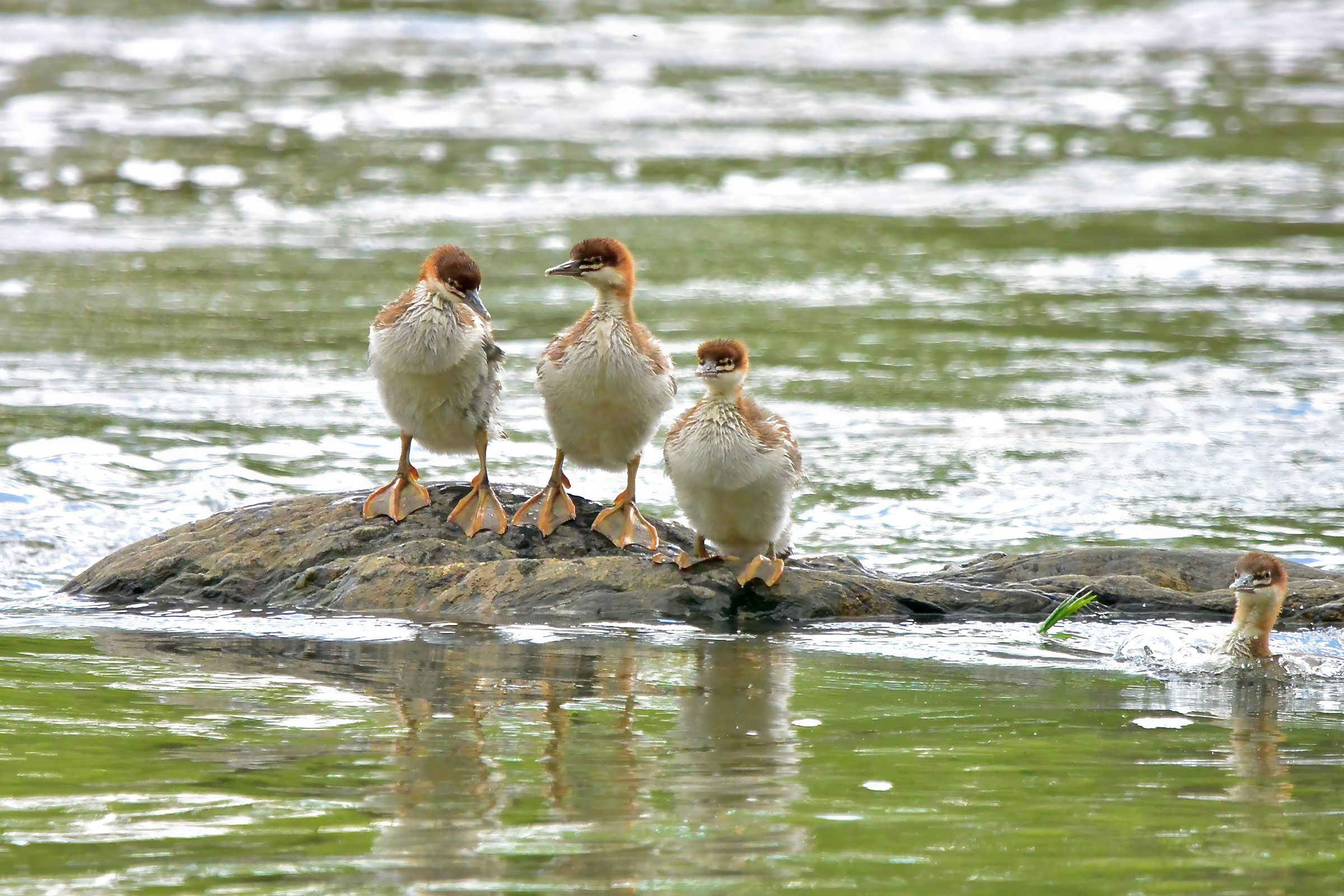Introduction
The Common Merganser is among the largest and most elegant ducks in Virginia. The male’s clean white body contrasts sharply with its dark green head, and the female’s cinnamon colored head sports a short crest. They mostly breed in riparian corridors (large rivers and creeks) passing through mature forest, where they nest in large tree cavities (Pearce et al. 2020). Common Mergansers are diving ducks that mainly eat fish; however, during the breeding season, they supplement their diets with invertebrates, such as caddisflies, mayflies, dragonflies, beetles, caterpillars, snails, and mussels (Pearce et al. 2020).
Breeding Distribution
Virginia is at the southern extent of Common Merganser’s breeding range (Watts 2015), though more recently the species has expanded into North Carolina. Its distribution in Virginia could not be modeled due to data and model limitations. For more information on where this species occurs in the state, please see the Breeding Evidence section.
Breeding Evidence
Common Mergansers were confirmed breeders in 47 blocks and 22 counties and found to be probable breeders in an additional three counties (Highland, Nelson, and Rappahannock) and in the city of Lexington (Figure 1). They primarily breed in the Mountains and Valleys region along various rivers, including the Calfpasture, Copper Creek, Cowpasture, Cranes Nest, Jackson, James, Maury, Middle, New, North Fork, and Shenandoah. Only seven of the confirmed breeding records were documented in the Piedmont region. These locations included Great Falls Park, River Bend Park, and Tamarack Bog in Fairfax County; Harpers Ferry, Loudoun County; Pen Park, city of Charlottesville; and the Rivanna Trail, city of Charlottesville.
Though no breeding evidence was reported for the species during the First Atlas, there were observations of single summering birds in four blocks that spanned all three physiographic regions of Virginia. Common Mergansers were known to breed in the state in the mid-20th century, with four records of hens with young documented between 1947 and 1965. These included three records in Rockingham County, two along the Dry River and one on the North River near Bridgewater (Jopson 1956). An additional breeding record was reported for Dyke Marsh in Fairfax County in the Coastal Plain (Scott 1966).
Breeding was exclusively documented through observations of recently fledged young from mid-April through early September (Figure 2).
For more general information on the breeding habits of this species, please refer to All About Birds.

Figure 1: Common Merganser breeding observations from the Second Atlas (2016–2020). The colored boxes illustrate Atlas blocks (approximately 10 mi2 [26 km2] survey units) where the species was detected. The colors show the highest breeding category recorded in a block. The numbers within the colors in the legend correspond to the number of blocks with that breeding evidence category.

Figure 2: Common Merganser phenology: confirmed breeding codes. This graph shows a timeline of confirmed breeding behaviors. Tick marks represent individual observations of the behavior.
Population Status
Detections of Common Merganser during Atlas point counts were limited to four individuals; thus, data were insufficient for the development of an abundance model. Though numerical population trend data for Virginia are unavailable, the species’ estimated breeding population more than doubled between 2003 and 2019 within the Atlantic Flyway between New Hampshire and Virginia (Roberts 2019). Based on the Virginia Department of Wildlife Resources (VDWR), this species has a growing population that is expanding geographically within the Commonwealth (Gary Costanzo, personal communication).
Conservation
Historic records of Common Merganser in Virginia and those ranging as far south as North Carolina (Jopson 1956) suggest a former, although limited, breeding population in the southeastern U.S., which underwent a range contraction due to hunting and river pollution (Pearce et al. 2020). However, since the 1980s and 1990s, recolonization of some former breeding areas to the north has been occurring (Pearce et al. 2020) and also appears to be taking place in Virginia since the early 21st century (Rottenborn and Brinkley 2007). Being near the top of the aquatic food chain, Common Mergansers are susceptible to poisoning from bioaccumulated toxic metals and pesticides within their prey. In Virginia, the most important conservation strategy is to maintain water quality and protect forested riparian corridors with big trees for nesting.
Interactive Map
The interactive map contains up to six Atlas layers (probability of occurrence for the First and Second Atlases, change in probability of occurrence between Atlases, breeding evidence for the First and Second Atlases, and abundance for the Second Atlas) that can be viewed one at a time. To view an Atlas map layer, mouse over the layer box in the upper left. County lines and physiographic regional boundaries (Mountains and Valleys, Piedmont, and Coastal Plain) can be turned on and off by checking or unchecking the box below the layer box. Within the map window, users can hover on a block to see its value for each layer and pan and zoom to see roads, towns, and other features of interest that are visible beneath a selected layer.
View Interactive Map in Full Screen
References
Jopson, H. G. M. (1956). Breeding of the American Merganser in the Shenandoah Valley of Virginia. The Auk 73:285.
Pearce, J., M. L. Mallory, and K. Metz (2020). Common Merganser (Mergus merganser), version 1.0. In Birds of the World (S. M. Billerman, Editor). Cornell Lab of Ornithology, Ithaca, NY, USA. https://doi.org/10.2173/bow.commer.01.
Roberts, A. (2019). Atlantic flyway breeding waterfowl plot survey, 2019. Maryland Department of Natural Resources. https://dnr.maryland.gov/wildlife/Documents/2019_AFC_PlotSurvey.pdf.
Rottenborn, S. C., and E. S. Brinkley (Editors) (2007). Virginia’s Birdlife: An Annotated Checklist. 4th edition. Virginia Society of Ornithology.
Scott, F. R. (1966). News and Notes. The Raven 37:55.
Watts, B. D. (2015). Breeding birds of Virginia. Virginia Journal of Science 66:223–276.




